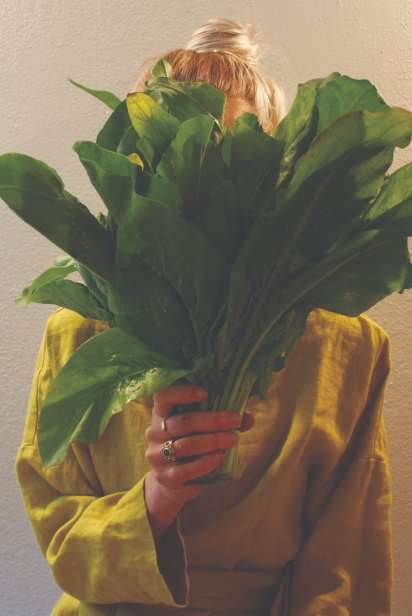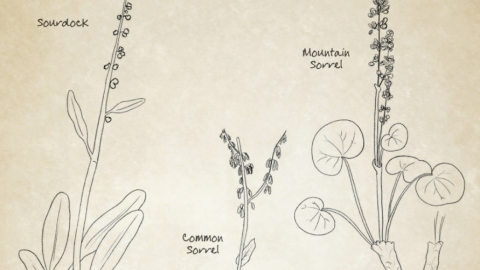Spring Greens
Sorrel and Sourdock
As the snow melts with the coming of spring in Alaska, we move from a season of greys and browns to the season of greens. Some of the most delicious greens of spring are the bright, tangy members of the Polygonaceae, or buckwheat, family. The genera Rumex L. and Oxyria, called sorrel and dock interchangeably, have lemony-tasting leaves and feature many species, some native and some introduced to Alaska. Varieties of sorrel and dock flourish throughout Europe and the circumpolar north. The varieties of these greens have distinct appearances and growing habits, but all have a tangy, tart taste that lends itself to culinary experimentation.
Humans have been consuming sorrel for thousands of years. Written recipes for the use of sorrel and dock can be found in ancient Egyptian, Greek, and Roman records, but the consumption of the green likely began before written history. Practices of harvesting, preparing, and preserving these greens as food and as medicine have been passed down for generations in Alaska and the circumpolar north.
A search for sorrel in the Anchorage Museum archives reveals some handwritten and illustrated recipes from Chukotka, the most northeasterly region of Russia located across the Chukchi Sea from Alaska. These recipes for traditional regional preparations were sent through an exchange in the year 2000 between school children in Chukotka and Nome, facilitated by Indigenous religious leaders and Alaskan missionaries. The missionaries sought to provide aid to communities in Chukotka in great need of food and resources. As a part of this logistically and culturally complex exchange between communities, children in Chukotka shared journals of their experiences harvesting and eating from the land. Their writings and drawings describe foodways that have many parallels with those of Alaska.
These journals, full of “national recipes” as they are described, show that they utilize mountain sorrel or sourdock, which grow well in the region. The recipes include simple sorrel salads with leeks, salt, and oil, sorrel porridge boiled and stirred until thickened, and sorrel served alongside the rich flavors of fermented reindeer offal. This exchange highlights how the pervasive, hearty nature and bold flavors of sorrels and docks are shared and enjoyed throughout northern climes.
Over a dozen species of sorrel and dock can be found growing in Alaska. Harvesters will find Oxyria digyna, or mountain sorrel, notable for its rounded, kidney-shaped leaves, flourishing in rocky environs at high elevation across circumboreal Canada, Alaska, and Russia. Rumex arcticus, or sourdock, grows tall with long pointed leaves and thrives in marshy lands. Species introduced to the state with colonization include Rumex crispus, or curly dock, and Rumex acetosella, or sheep sorrel, both of European origin and which now can be found growing wildly throughout much of the state. Rumex acetosa, most often called common or garden sorrel, also was brought to Alaska from Europe and flourishes in Alaska gardens. While not frost tender, garden sorrel grows well in most soil types and is quite tolerant in a variety of conditions, making it an easy green to grow for new gardeners. Whether wild harvesting, gathering from the garden, or farmers market shopping here in Alaska, these spring greens offer bountiful possibilities for delicious and purposeful use.
Dr. Allison Kelliher of Snow Creek Medicine harvests and uses sorrel and dock as food and as medicine. A family doctor with an MD from the University of Washington School of Medicine, she integrates her work as a Western medicine doctor with her experience as a traditional Alaska Native healer with special wisdom about plant medicine. Dr. Kelliher is said to be the first Koyukon Athabascan to become a medical doctor. She earned a bachelor of science in Interdisciplinary Studies, Indigenous Medicine in 2001 at the University of Alaska Fairbanks before earning her medical degree. She harvests sorrel wild and also grows common sorrel in her garden. “It’s a very valuable plant that has been used and continues to be used,” she says.
When wild gathering, Dr. Kelliher provides important guidelines for conscious harvesting: “a gentle thought: honor the plant by preparing yourself.” This means planning to harvest at proper times of day and dressing appropriately by wearing garments that recognize the gift of the plant. Dr. Kelliher described childhood memories of her relatives wearing kuspuks when wild harvesting, and she often wears her kuspuk today when gathering. When traveling across the land, she says, vary your routes so as not to trample or erode the landscape. The plant should be harvested quickly and cleanly, and Dr. Kelliher recommends placing it in a breathable bag, such as a cotton pillowcase. Gather no more than onethird of any plant to allow for continued growth. Talking about wild and farmed greens alike, Dr. Kelliher says, “Watch plants over the seasons, consider that relationship. The plant is talking to you and asking you to harvest it more at certain times.” She prefers to harvest the greens in spring and summer, as later season leaves become bitter.
Dr. Kelliher suggests using the tender, young leaves raw in salads. She recommends keeping leaves whole or gently slicing and mixing them with an oil like olive or seal. As a food, sorrel is high in micronutrients including vitamins A and C, and so consumption with proteins and fats heightens absorption of the rich nutrient content. Alongside fish or muktuk, sorrels and docks can serve as a digestive aid due to their bitter qualities.
Despite sorrel’s flourishing in spring and summer, Dr. Kelliher describes sorrel as a “winter green” because it can be preserved for use long after its season. Fermented sourdock, often preserved in seal oil, is a recipe passed down amongst some Alaska Native peoples for generations. In addition to fermentation, Dr. Kelliher recommends drying leaves in a dark space without heat until they snap. Doing so preserves their nutrients for future use. These dried leaves can be used as a tonic, with one teaspoon of crushed leaf per cup of hot water, steeped for 5–10 minutes. The tonic offers preventative support with its nutrient and bitter constituents. Dr. Kelliher suggests taking the tonic during moments of seasonal transition when eating and lifestyle habits change, and the body can become more vulnerable to illness.
Mark Rempel of Rempel Family Farm is another advocate of sorrel which he grows in abundance on his certified organic farm in Palmer and sells at farmers markets. He explains, “I started growing sorrel on a lark.” He first developed a taste for sorrel and dock wild harvesting while living in Kotzebue as “your body craves the food of the region [where] you are,” he explains.
Now, Rempel grows a garden sorrel on his farm. He cautions emerging gardeners that the seeds are very small and few are needed for a substantial yield. He joked, “You might only need four seeds, but of course you can’t buy that few.” Planted densely, an inch apart, the seeds will sprout easily. Rempel begins his seeding in April in his greenhouse, but also suggests garden sorrel does well with direct sewing into the ground. The plant is so hearty, he recommends cutting it down to the root rather than plucking the tart, tangy leaves because they will burst back up in flavorful bunches. Rempel advises that garden sorrel can be quite tenacious— even rototilling it back into the earth will not kill it, and it will pop back up in the same place in spring. When Rempel eats sorrel, he likes to chop and mix it with sour cream to spread on salmon in the last moments of grilling, which adds a piquant, lemony twist.
Given the hearty nature of the Oxyria and Rumex genera, these greens are an accessible addition to any Alaska kitchen. Versatile for both savory and sweet preparations, this spring green is delicious raw, cooked, and even baked. The bright, tangy flavors of sorrel and dock pique interest and appetite while adding nutritional value. So, next time you find yourself wandering through boggy lands, or the aisles of the farmers market, keep your eyes peeled for sorrel or dock to eat now as a spring green, or later for a winter green delight.
Dr. Kelliher notes that all species of sorrel and dock are high in oxalic acid, an organic compound that actually receives its name from the genus of some sorrels, Oxyria. Oxalic acid occurs naturally in many foods and can also be found in amaranth, spinach, rhubarb, broccoli, cabbage, brussels sprouts, parsley, and even starfruit. She cautions that while consuming oxalic acid-containing foods is generally considered safe, diets high in the compound have been tied to kidney stones in some individuals.

















